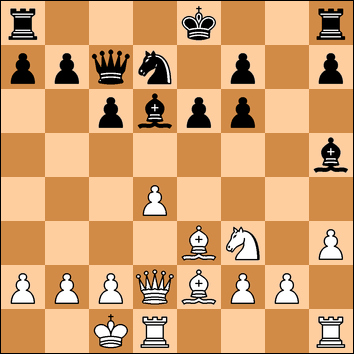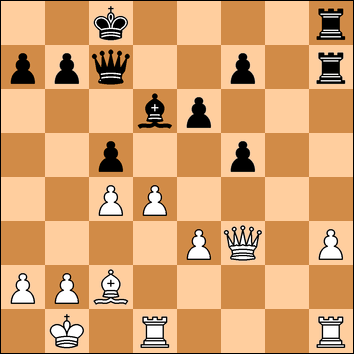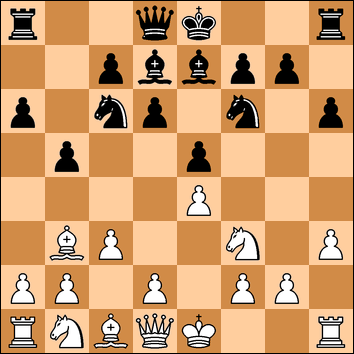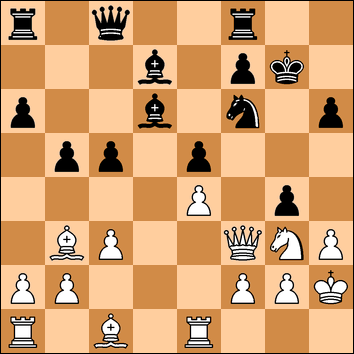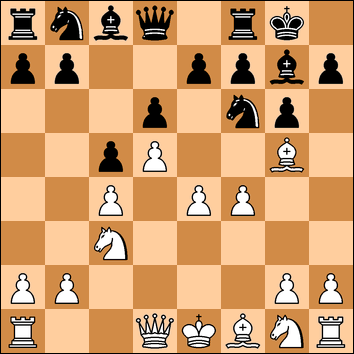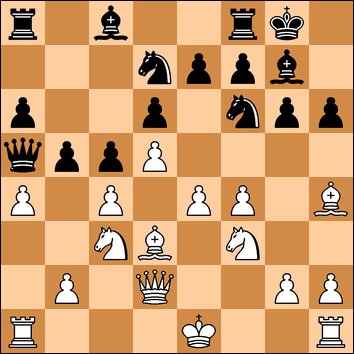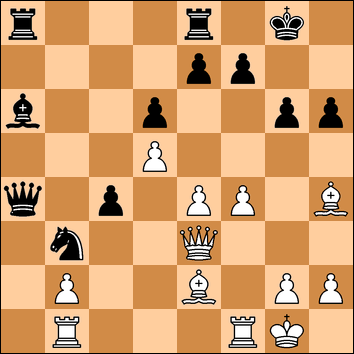Thursday 25 February 2016
White: D. Barnes (153) Black: K. Nevols (132)
After a bad defeat last week, and now three losses in the last four, I felt low in confidence. So I was not too pleased to find myself as Black against a player graded 153. As we waited for the game to start, I decided my tactics - to play casually and carefully, no sacrificial heroics, calm positional chess - to meet e4 with the Scandinavian d5 - and to meet d4 with the solid d5.
1. c4
Well, there goes that theory. The English Opening.
1. .... e5?!
Now this move is not dubious in itself. But I enter an aggressive line against the English - a mistake having just decided to play calmly and positionally. Looking back I should have played 1. .. c5 and aim to play symmetrically.
2. g3 d6
3. Bg2 f5
This is it - the system is similar to the Dutch where Black has already played e5. The first few moves are straight forward and the plan is for Black to get some aggression on the kingside.
4. Nc3 Nf6
5. d3 Nc6
6. e4
Blocking the diagonal. 6. Nf3 might be a better way to play for an advantage.
6. .... Be7
7. Nge2 O-O
8. O-O
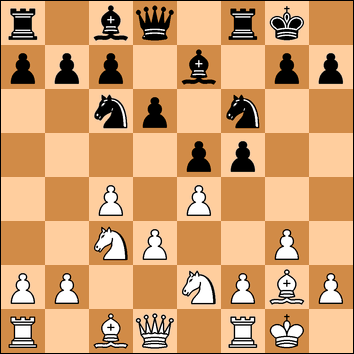
So now for a plan. As I said, this system for Black demands aggression and so I head my queen off in that direction.
8. .... Qe8
9. Nd5 Bd8
If 9. ... Nxd5 10. cxd5 Nb8 11. Qb3 is annoying. However White will have to do something about the second d-pawn so might consider 11. d4 with some complications in the middle.
Or 9. ... Nxd5 10. exd5 Nb8 11. Nc3 and White is better.
Of course Black does not have to drop the knight back to b8 and could go for Nb4 or Nd4.
With complications not on my agenda, I decided on some passive defence - as well as freeing up the e7 square for the knight - and the computer agrees that Bd8 is the best move.
10. Rb1
I didn't really understand this. Presumably preparing b4 but Bd2 might be a better way to seek that objective.
10 .... Qg6
A probe towards the king and threatening to win a pawn on e4 - although exchanging pawns beforehand to clear the bishop diagonal might have been better. 10 ... fxe4 11. Nxf6+ Bxf6 12. Bxe4 Bg4 or 11. dxe4 Qg6.
If now 11. N2c3 I was considering 11. ... Nd4.
11. f3
Solid but slightly loosening and making me think of sacrificial ideas around the king but everything is covered. Here 11 .. f4 is nothing. 12. gxf4 Bh3 13. Rf2 or 12. g4 h5 13. h3. And it is not too late to take on e4 with 11. .. fxe4 12. dxe4 Be6 or 12. fxe4 Bg4.
11. ... Ne7?!
Instead I decide that it is about time that knight on d5 was evicted. The problem with this move is that it blocks the bishop's defence of the knight on f6 and hence the White knight will have to be retaken with the rook.
12. Be3!
A good move - developing the bishop towards the queenside, blocking any ideas of c6 and Bb6, and giving an option of an initiative with Rc1 and c5.
12. ... c6
13. Nxf6+ Rxf6
14. d4 Rf8
A bit of reorganising but I thought 14. ... Bb6 might have been better where the bishop takes a more active square and Black could think about putting a rook on the d-file.
(The computer points out that 14. ... Bb6? is a mistake. It gives the line 15. c4 exd4 (15. ... Bc7 16. cxd6 Bxd6 17. dxe5 Bxe5 18. Qd8+ Kf7 19. f4 with a strong initiative - in this line, that Rb1 move has come in very useful) 16. Bxd4 Bxc5 17. Bxc5 dxc5 18. Qd8+ Kf7 19. e5! Re6 20. Nf4. It thinks 14. ... Be6 is an improvement - although my move 14. .. Rf8 is not the end of the world).
15. Qd2 Be6
Wanting to close the centre but giving White some initiative. Maybe grovelling with 15. .. Bc7.
16. d5 Bd7
White now has 50 minutes for 19 more moves and I have 31. The time control was the usual 35 moves in 75 minutes and then 15 minutes for the rest - a fast control which I seem to struggle with.
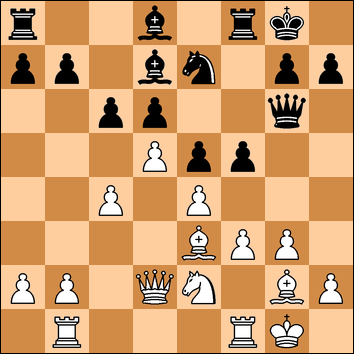
17. dxc6?!
Interestingly, our electronic friend thinks this gives up White's advantage - it prefers either 17. Qb4 or keeping things very complicated with 17. f4.
17. .... Nxc6?!
And it thinks I return the favour - preferring 17. ... Bxc6 - but I wanted to get the knight into the game.
18. c5 Be7?
A mistake. 18. ... Be6, activating the bishop by countering against the a-pawn is better. After 19. a3 or b3 then dxc5 20. Bxc5 Bb6 and a rook is coming to the d-file.
19. Rbd1!
A good move which I had overlooked. White builds up pressure on the d-file.
19. ... fxe4
20. cxd6 Bd8
21. fxe4 Ba5
Taking up a more active position. I now have 20 minutes left for 14 moves.
22. Nc3! Bg4
23. Rxf8+ Rxf8
24. Rf1 Rd8
I felt I was defending quite well here. I am surrounding the d-pawn - his bishop on g2 is not doing anything - and my pieces are seeing some activity.
25. Bc5 Nd4?
But now I start to go wrong. The upcoming knight manoeuvre completely escaped me. The move I glanced at was 25. .. Bc7 which I rejected because of 26. Nb5 Bb8 - not seeing the simple fact that White wins at once with 26. dxc7! (26. .. Rxd2 27. Rf8 mate). 25. .. Bb6 would be better.
26. Qf2! b6??
Afterwards we looked at 26. .. Bxc3 27. bxc3 Ne6 but White still gets a huge advantage with 28. Bxa7. 26. ... Be6 is another possibility but again 27. Bxa7. Maybe Black is already lost here - but my move loses a lot quicker.
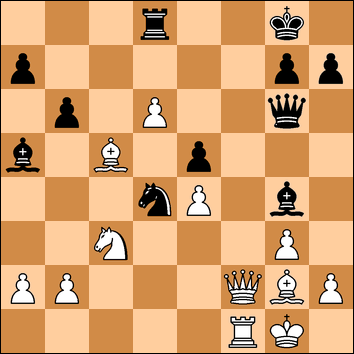
27. Nd5!
Crunch!! Didn't see that. It's all over. The knight is coming to e7 with deadly force. I play a few more moves but the end is inevitable.
27. ... Ne2+
28. Kh1
28. ... Qe8 would have at least extended the game by a few moves. 29. Ba3 then 29. ... Be2 30. d7! or 29. ... b5 30. h3 picking up the knight or 29. .. Nd4 30. b4. But in any event I was now resigned to resigning.
28. . ... Nxg3+
29. Qxg3 Qe6
30. Ba3 Bd2
31. Qf2 Resigns
White is coming out of this a piece up and, with my clock reaching the last minute, I decided it was time to call it a day.
